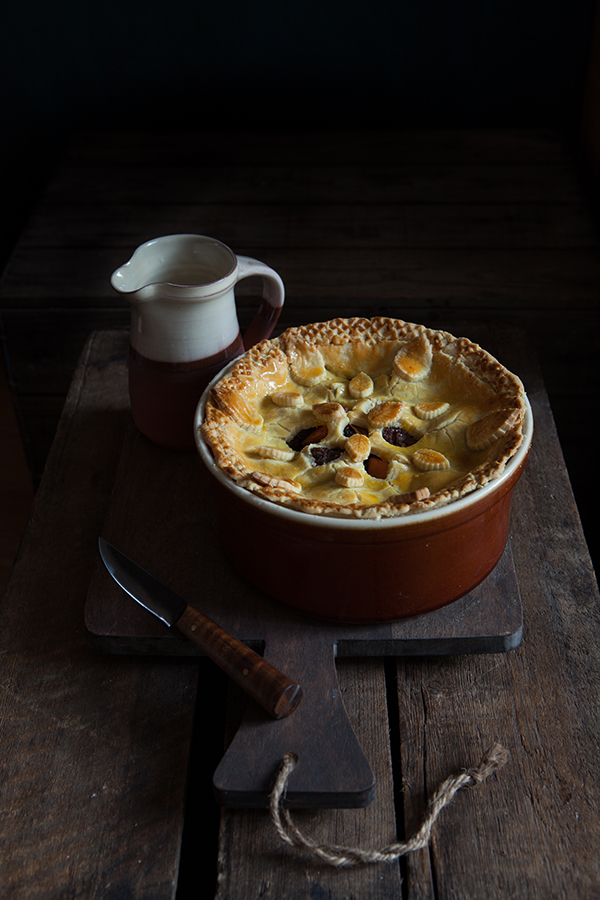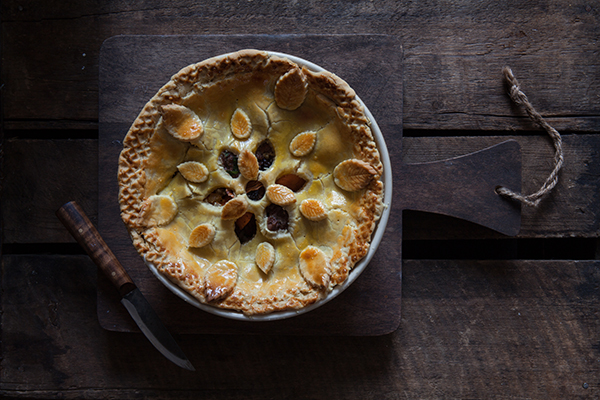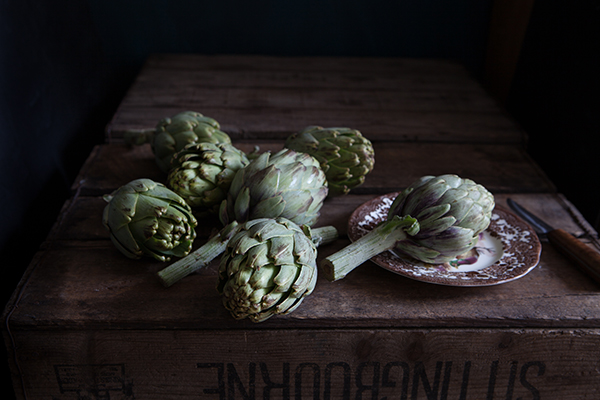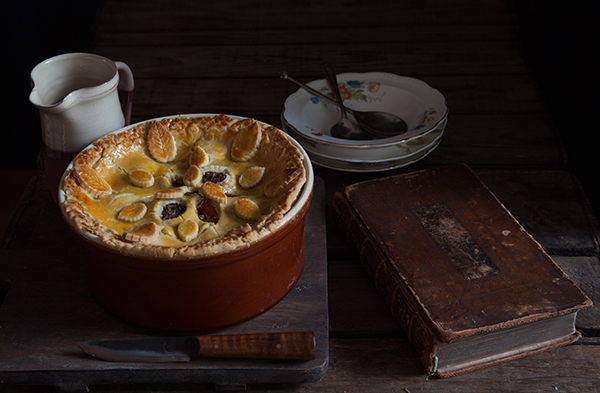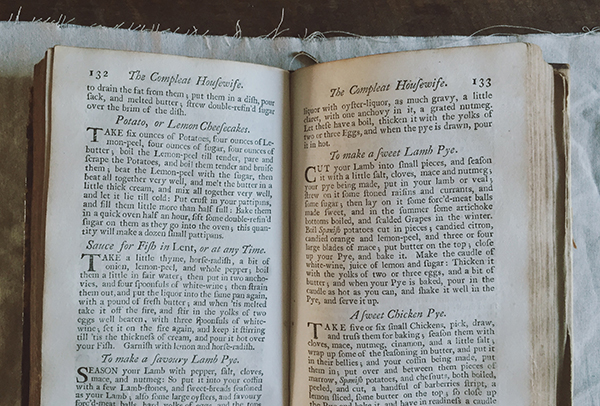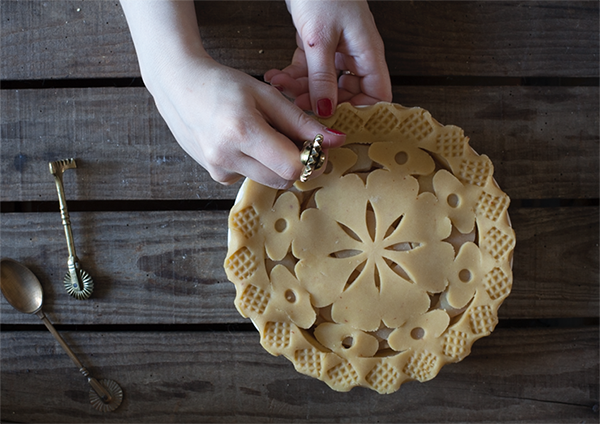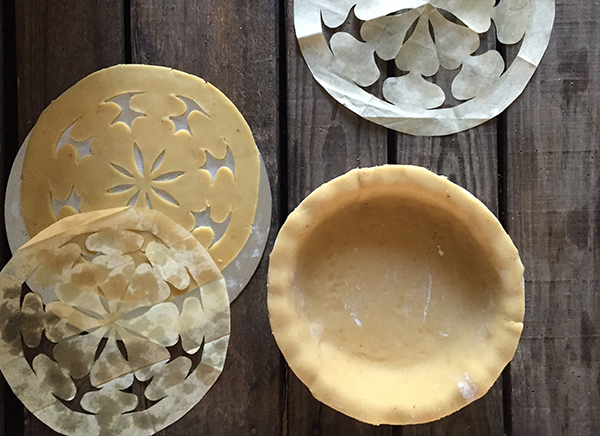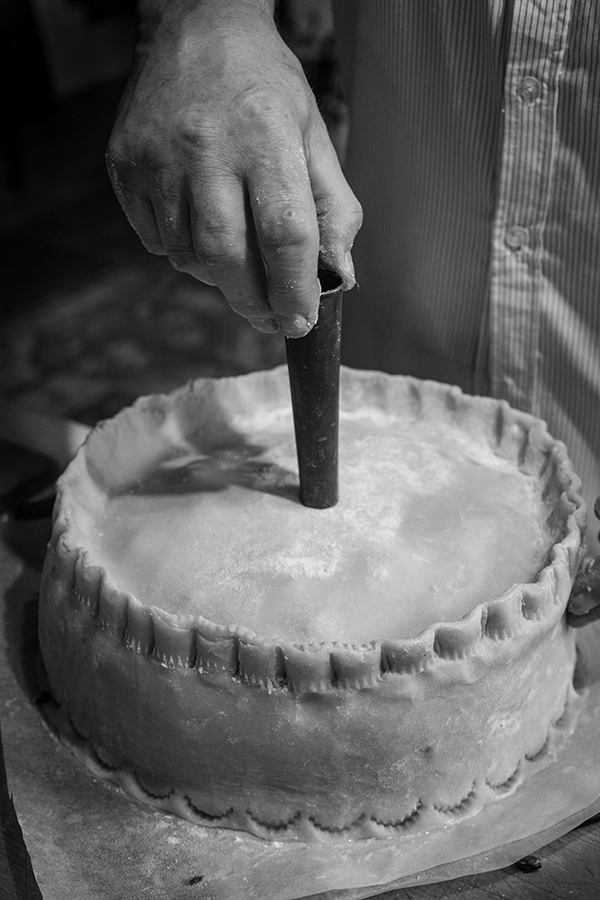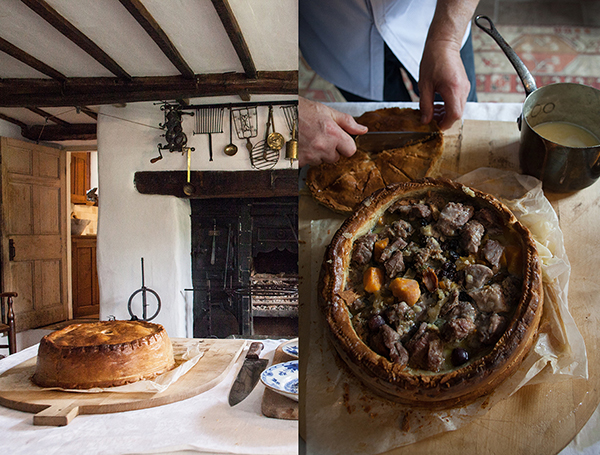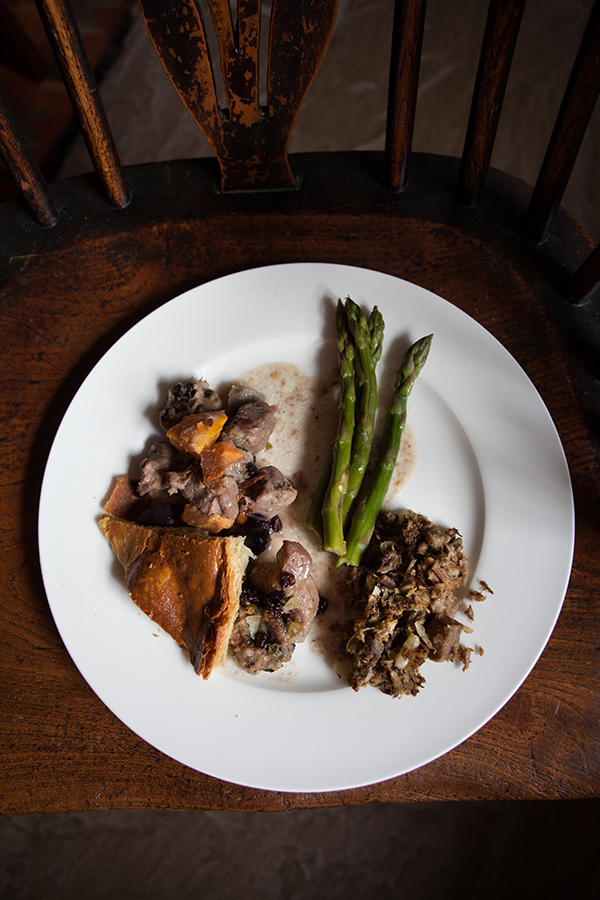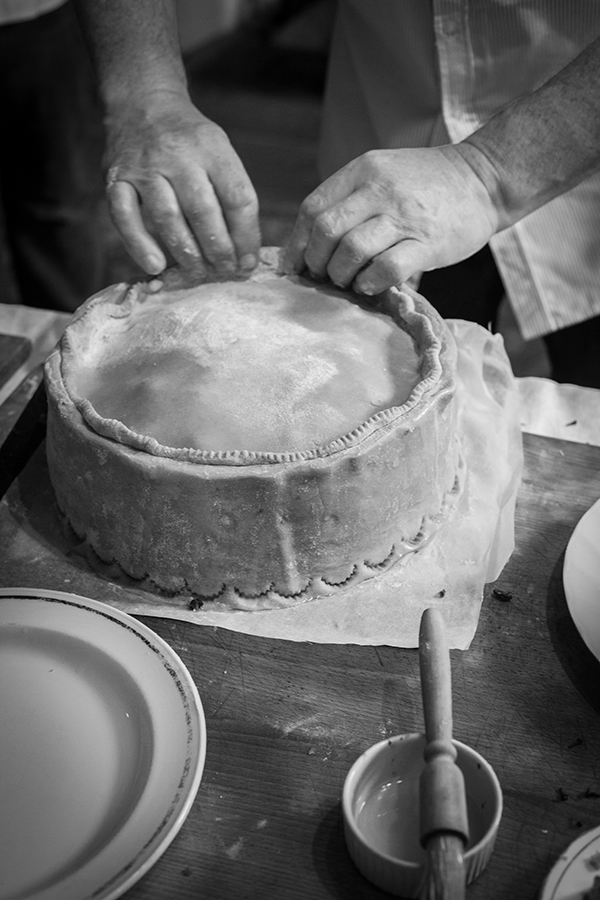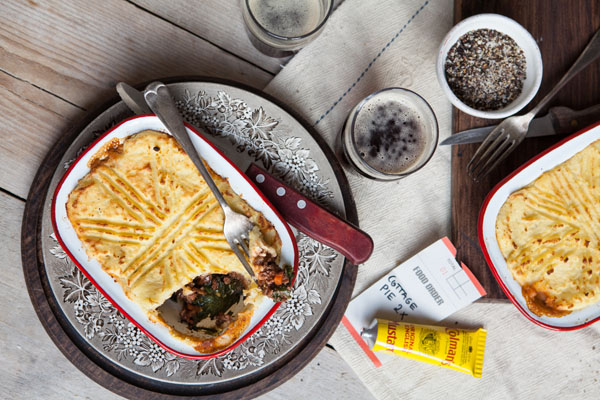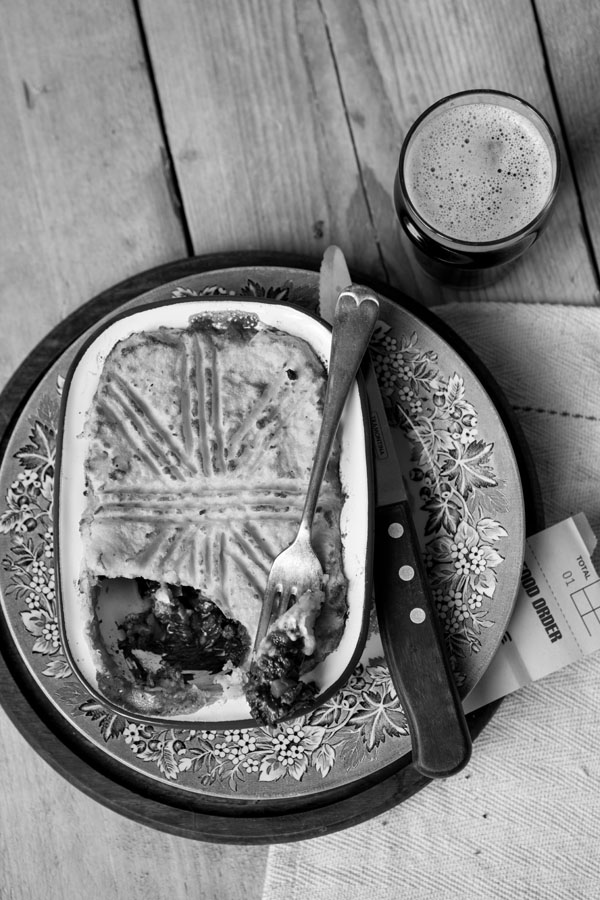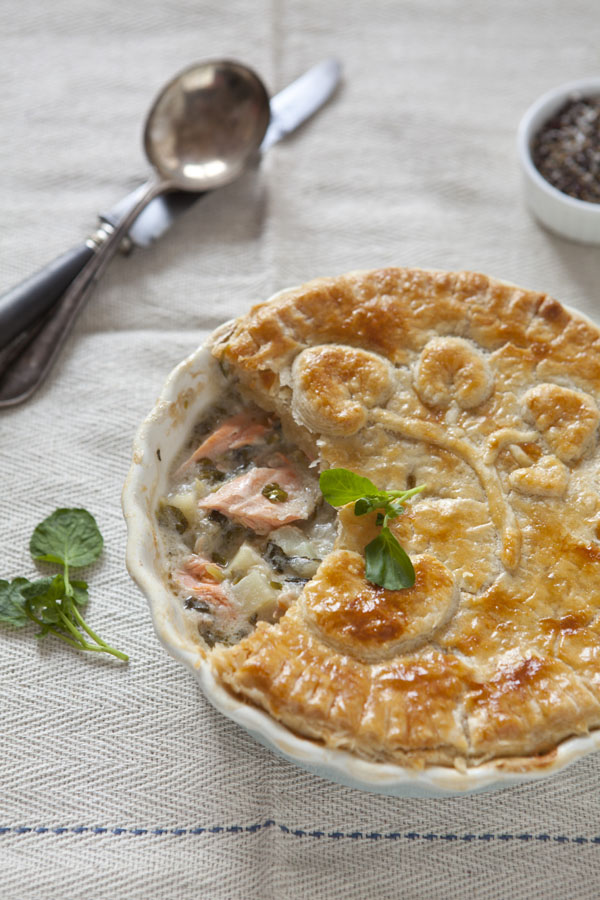The post 18th century Sweet Lamb Pie appeared first on Miss Foodwise.
]]>When I tell people about my passion for historical dishes, there are always those who look at me with disbelief and some amusement. They claim those ancient dishes were made of rotting meat masked with an abundant use of spices, or stodgy pottage, all eaten with the hands like barbaric creatures. It can’t be good, it can’t be imaginative, it just can’t be …
The theory that food in the Middle Ages was highly spiced to mask the flavour of rotting meat has been discarded as pure nonsense in the last ten years. Those who were served spiced dishes were privileged, those cooking with it were the master cooks to kings and queens. People of status that not only could afford this immense luxury, but also had a good supply of fresh meat and fish from their estates and beyond.
Our ancestors – of the elite – had a good understanding about spices, and how to combine them. Those flavour combinations would often taste peculiar to us. Not at all in a wrong way, but in a way that you realise it is a flavour sensation you have never tasted before.
This brings me to how tastes have changed.
Today everything is usually either sweet, salty or spicy. Bitter is making a modest comeback and sour too, but these flavours are seldom combined in our ‘modern’ European cuisine. It is even so that a lot of our foods are processed in factories which add flavour essences to make the food taste the same every time you prepare it. Of course this doesn’t happen when you cook from scratch, but it is an unfortunate fact that people in the UK buy a lot of ready meals. It is a trend that has luckily not taken off in Belgium, but it is very possible we’re not far behind. Joanna Blytham recently published a book about these practices in food processing factories, and she rings an alarm bell and employs you to smell your food, to taste, and realise the smells and tastes are not from natural ingredients. This is an evolution, when more people eat processed food, they get an idea about how tomato tastes, and how a beef stew should taste. It goes so far that when those people taste the real thing, they can’t take the sourness of a real tomato, the texture of the skin, and they find their own beef stew too bland and wonder where the flavour of the ready meal comes from. It’s not tomato, and it’s not beef. Butter in buttery pastry is not butter but other fats, with added butter flavour. It might taste like butter, but it might not completely and it might even change your taste and idea of how it should taste all together. I will go into Joanna’s eye-opening book in another posting but you get the idea for now. Today many of the people taste food, but don’t really taste the produce. Their tastes change. A very simple example is when I give someone a glass of raw milk to drink, I am used to it and drink it all the time, but my guests often can’t finish another sip because they find the flavour too ‘animal-like’. Most milk you buy in the supermarket to me tastes like white water, but this is how the people think milk tastes like these days.
Eliza Smith’s Sweet Lamb pie from 1727 is one of those dishes that really show off the old way of spicing food. The flavours come through in layers if you get what I mean. It is not really sweet, but the spices that are used, nutmeg, mace and cloves were considered sweet spices and used as a sweetener. Sugar is added too, but used rather like a spice. In addition to these spices, currants and candied peel are added to bring extra sweetness. Then also sweet potato is added, and artichoke hearts. The 1727 book also mentions that when artichokes aren’t in season, one can use grapes too.
The pie is built with pieces of diced lamb, dusted in the spices, and meatballs made with lamb meat, suet, currants and the same sweet spices with the addition of fresh parsley.
Layers are constructed of lamb, lamb meat balls, sweet potato and artichoke.
When your pot or pie is full, a blade of mace is added and the pie is placed in the oven for just over an hour. Just when you’re ready to serve, a ‘Caudle’ is made, this is a sauce which is added to the pie by pouring it in when you are ready to serve. It is usually there to lift the flavours of the dish. In this case the caudle is made with white wine, lemon juice, a little sugar and a couple of egg yolks.
This sauce gives the dish a little acidic kick and will guaranty you to want to empty the saucepan until the very last drop.
The pie can either be made in a free-standing pie crust like you see in the pictures I took when I was at Food Historian Ivan Day’s house, for a weekend of Georgian cooking last year. A hotpot is however another way of making this pie, this is a closed casserole dish used in the North of England, or you can use a deep oven dish and add a pastry lid, which is what I did the last time I made the pie, and what you can see in the first pictures here.
I made this Sweet Lamb pie not too long ago when we had two chefs coming for dinner, I did not know how they were going to react to the flavours of this dish.
Fortunately my friends are all about good, honest and natural food so they were eager to try. And they enjoyed it, one of the duo even asked me if it was okay to lick his plate and clean out the saucepan of caudle.
I say that’s mission accomplished, don’t you think?
The pie is incredibly flavoursome and eats just wonderful with the different vegetables and meat; the addition of a piece of salty pie pastry is a bonus but not a must if you aren’t up to making your pastry, but please don’t use shop bought pastry… that is just plain evil and doesn’t even contain butter!
I made the pie you see in the pictures above with pastry I had leftover from my recent pastry project… You might have spotted it on instagram.
18th century Sweet Lamb Pie
- 250 g lamb meat from the leg
- 250 g lamb mince (if you buy a leg, you can use the leftover leg to mince)
- 2 large sweet potatoes, parboiled, cut in dice
- 4 small or 2 large artichoke hearts, parboiled, cut in dice
- or when you don’t have artichokes, use a handful of grapes, blanched.
- 1 tsp of ground mace
- 1 tsp of ground nutmeg
- 4 cloves, beaten
- 2 blades of mace
- a generous pinch of good black pepper – or 3 pieces of long pepper, beaten
- 1 tsp each of candied lemon and orange peel, in small cubes
- 50 g of shredded suet
- fresh parsley cut finely, about 1 tbsp
- currants 50 g
For the Caudle
- The juice of 1 lemon
- The same quantity of white wine
- 1 tsp of sugar
- 1 egg yolk
- a little knob of butter
Preheat your oven to 160° C
Beat your spices, but leave the two blades of mace whole.
Dust the meat with half the spices, add the other half to the minced meat.
Make your minced meat balls with the spices, suet, parsley and 2 tbsp of currants.
Have all your components of the dish ready so you can start making the layers.
Place some meat, meatballs, sweet potato and artichoke into your dish or pastry and strew over some currants and candied peel, continue until the pie is full.
Close the pie with pastry, making a hole for steam, or put the lid on and pop in the middle of your oven for 1 hour to 1hr and 15 minutes. This could be longer, it depends on the quality of your meat, decent meat needs less cooking. So try and taste, when you have a pastry cover, user a skewer to prick to see if the meat is tender.
When ready, take out of the oven and make your Caudle.
Bring your wine and lemon juice to a simmer with the sugar, in a separate bowl, have the yolk ready and add the warm caudle like you would for a custard. Finish with a little knob of butter and warm again over the fire.
Pour the caudle into the pie, and serve. The caudle will mix with your pie juices and create a sauce.
If you’re making pastry, this is an easy recipe to try
For the pastry
- 300g plain white flour
- 100g unsalted butter
- 100g shredded suet
- a generous pinch of salt
- 125 ml ice cold water
- 1 egg, beaten
- Combine the flour, butter, suet and salt in a large mixing bowl and use your fingers to rub the butter into the flour. Keep on doing this until the mixture resembles breadcrumbs.
- Pour in the water and start pressing the liquid into the breadcrumb-like mixture. Be gentle as you must be careful not to overwork the dough.
- When you have created a rough dough, wrap it in cling film and let it rest in the fridge for an hour or more. You can prepare the pastry the day before if you’re feeling organised.
- Use the beaten egg to eggwash the edges of the piedish.
- Take your pastry out of the fridge and place it on a floured work surface. Now roll out the pastry about 1 cm thick and make sure it’s larger than your pie dish.
- Now carefully pick up the pastry and place it over the pie dish. Trim off the edges of the pastry so you get a nice lid. Now crimp the edges by using your thumb or a fork so the pastry lid is closed tightly. Make a hole in the middle so steam can escape.
- Decorate the pie lid if you like and eggwash generously before putting into the oven on one of the lower parts.
Serve with green asparagus if you have them, or green beans, or just as it is.
The pictures below were taken at Ivan Day’s Georgian cooking weekend in the Lake District
The post 18th century Sweet Lamb Pie appeared first on Miss Foodwise.
]]>The post George, the Dragon and the Cottage pie appeared first on Miss Foodwise.
]]>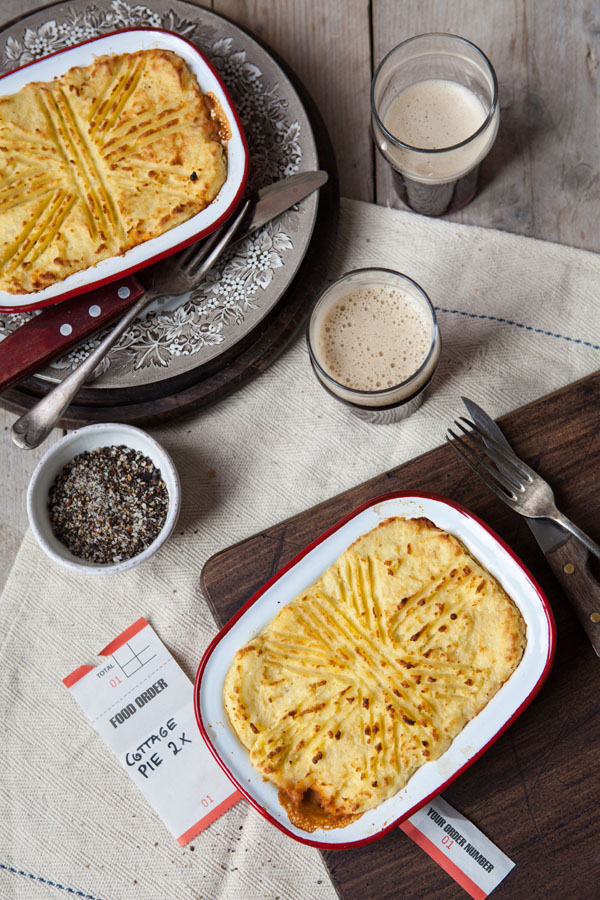
Wishing you all a happy Saint George’s Day with these humble cottage pies. I’ve been mostly working on my book, stuck with my nose in research and absolutely loving it but in the evening I long for great simple food with pure flavours. This pie is just that, with the best spuds you can find for your mash, decent flavoursome beef and a layer of moist spinach, this is a treat for me. I just wrap it in a towel and relax with a beer and a movie.
No doubt you will all have been waiting for the dragon slaying moment in this story but unfortunately I will have to disappoint you as there are no dragons in this tale.
Then the tale of George and the dragon appears in the Legenda sanctorum or Golden legend, a collection of hagiographies (stories of the Saints) by Jacobus de Voragine. This book of which there were over a thousand of manuscripts in the 13th century was very popular and was one of the first books that were printed in the English language when printing was invented around 1450.
So what are you up to today?
- 400 g beef mince, from chuck steak
- 1 large chestnut mushroom or a white one
- 1 stalk of celery
- 1 small carrot
- 1 clove of garlic
- a knob of butter to fry the meat and veg
- 1 small tin of tomato puree 50-70 gr (concentrate of tomato)
- 1 glass of red wine or stout beer like guinness – 250 ml
- 2 teaspoons of Worcester sauce
- 300 ml of beef or vegetable stock (I use an organic vegetable stock cube)
- Salt and pepper to taste
- A few handfuls of fresh spinach (you can use from your freezer too)
- Potato mash, you need 4 large spuds or use leftover if you have some
- Add 4 teaspoons of grated cheddar cheese
- 2 individual trays, or one larger one. Small pie pans work well. (14×19)
Method
Cook your spuds and make your mash with milk, butter, nutmeg and salt. If you like to make it richer, add an egg yolk too. You need a silky smooth mash which is slightly wetter than you’d eat it normally as it dries a bit in the oven.
Chop all the vegetables and add to a heavy based casserole, glaze a little over a medium flame and then add the meat. Brown the meat and add the tomato puree, stir well to combine evenly
When the tomato starts to caramelise – which means stick to the bottom of the pan, pour in the wine or beer. Stir to loosen up the meat and veg.
Let the booze evaporate, it takes about a minute, and it will be reduced a lot. If you don’t want to use alcohol, use water or stock
Now pour in the garlic, stock, and the Worcester sauce and put on the lid, leave for 30 minutes but check on it frequently so it doesn’t burn to the base. You may leave it longer too, it is merely for the flavours to develop.
Use boiling water from the kettle and blanch your spinach, drain and add a cube of butter, you may omit this but butter does taste so very well.
Preheat your oven to 180°C
Place your spinach in your chosen baking tray or trays, season with pepper.
When the meat is ready, transfer it to you tray or trays.
Now make the mash layer by scooping blobs of potato on the meat, then spread out.
You can pipe this mash, but who has the time to pipe mash on a weekday??
Place into the oven under the gril for about 10-15 minutes or until your mash has some color. It depends really on what you like, lightly coloured or not.
Serve with a beer, or wine if you like.
Put the rest in the freezer, we usually have some leftovers. These pies freeze very well, just defrost in your fridge overnight when planning to use.
Enjoy
You might also enjoy
Beef and Oyster pie
Watercress and trout pie
Sussex Stewed steak
Thank you for leaving a comment!
The post George, the Dragon and the Cottage pie appeared first on Miss Foodwise.
]]>The post Watercress and Trout Pie – Fit for a Watercress Queen appeared first on Miss Foodwise.
]]>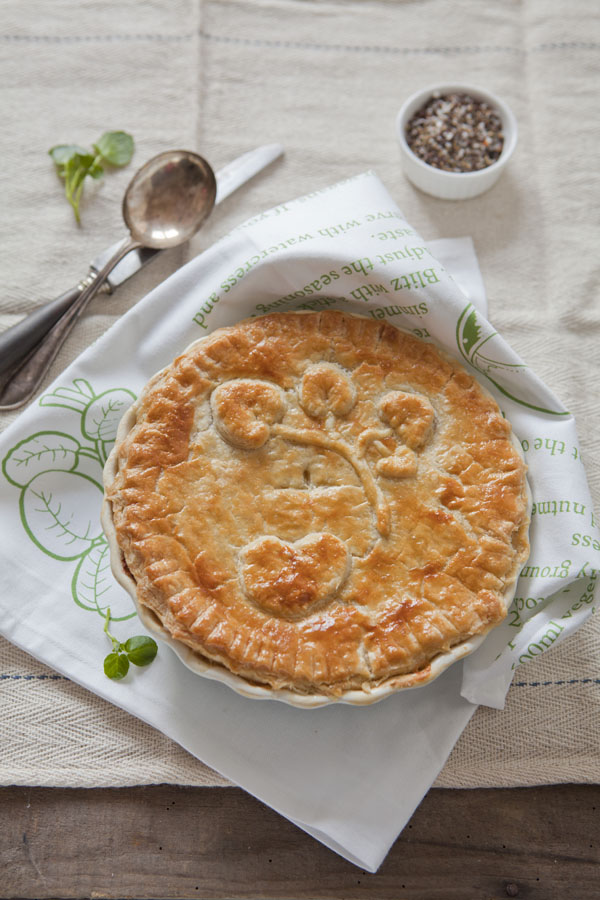
Let me tell you a story about a strong independent woman, a working class woman who became one of the most iconic figures in British food history. Her name was Eliza James and she was called ‘The Watercress Queen’.
In the late 1800, the little Eliza went from factory to factory in Birmingham with her bunches of wild watercress. As ‘the poor man’s bread‘ was so popular with the working class she soon started to sell larger and larger quantities. She worked her way up and moved her business to London where she soon became the favoured supplier of nearly all the London restaurants and hotels. She was able to acquire watercress farms in Hampshire and Surrey making her the biggest owner of watercress farms in Europe. But even when she became part of a well-to-do class, she remained to work at her Covent Garden stall for over 50 years.
Steve – who you might remember from last weeks post – explained that Eliza founded the James & Son company and trade marked the name Vitacress, the name Vitacress was then sold on to Malcolm Isaac who founded Vitacress Salads which is the name of the company today. Eliza’s Hampshire farms are still producing watercress to this day and are still a part of Vitacress. The farm I visited was one of the original farms and made me think about Eliza James and her hard work. I think she deserved her title and isn’t it just one of the most romantic stories of a working class woman trying to build an emporium out of watercress, to do well by herself and her family.
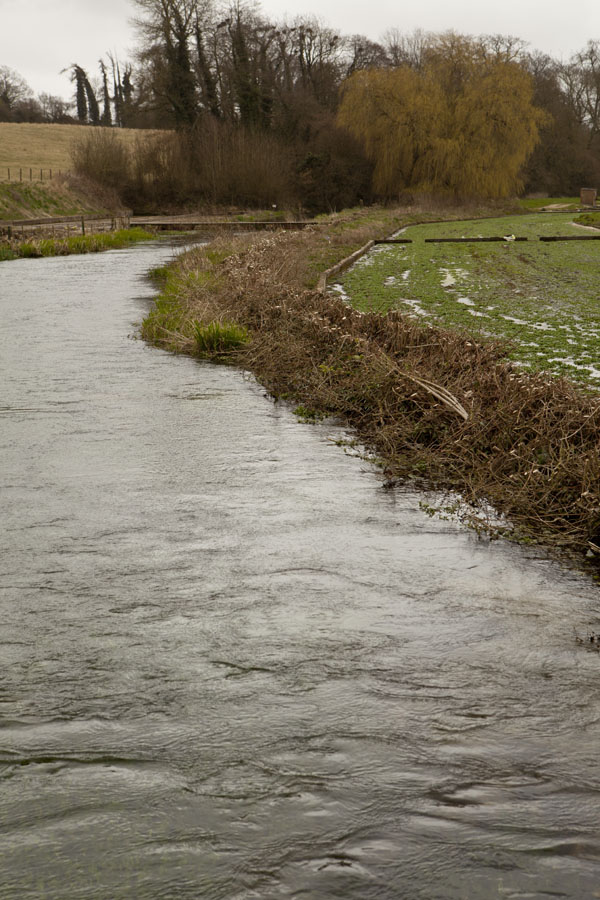 |
| The stream that feeds the watercress beds |
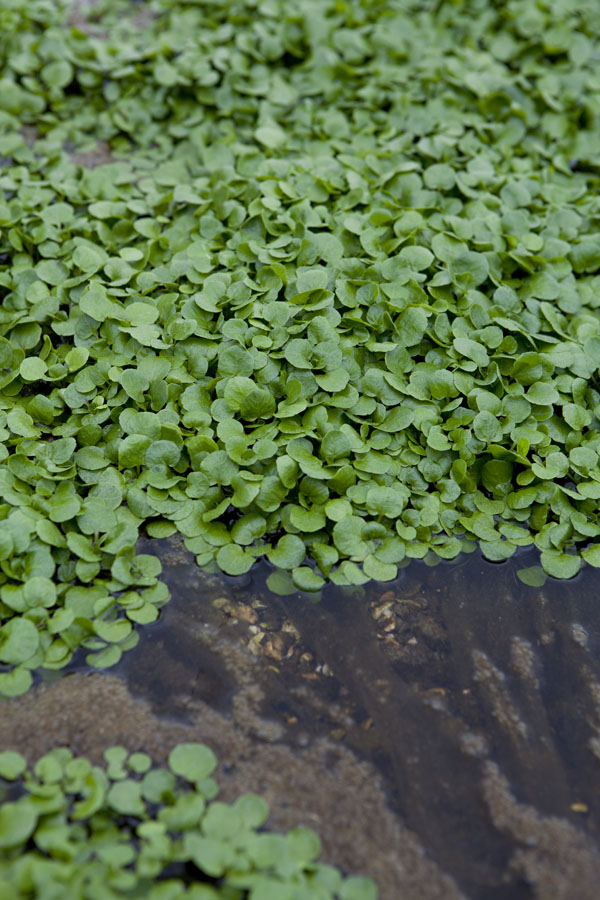 |
| Baby cress |
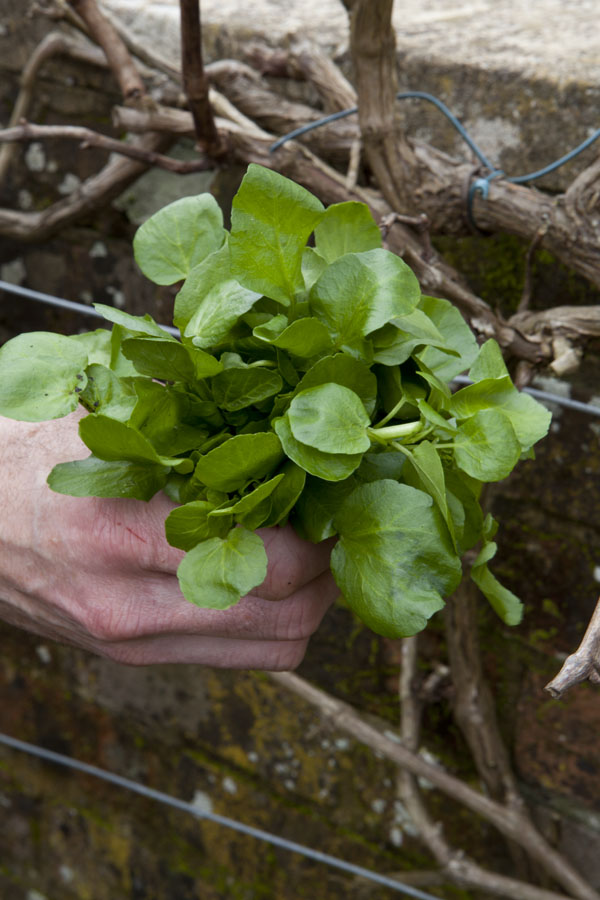 |
| Steve and his Poor Man’s bread from previous post |
As promised earlier this week here I am with my watercress and trout pie. Spring has been dreadfully cold and rainy and although I am longing for crisp green salads a pie is now very much needed to warm the spirits.
With my last bit of watercress from the farm in Hampshire I opted to bake a silky smooth fish pie. The river that feeds the watercress beds in Hampshire is full of brown trout so when I was at my fishmonger I opted for trout. With my only option being Steelhead trout today, the meat resembling more that of a salmon though less strong tasting and more delicate. I don’t care for salmon at all and avoid it where I can, unless cured, I do like salmon cured..
Water is so very important to watercress, it has to be clean spring water. The watercress leaves and stalks seem to be holding the water tightly, hanging on to all the goodness is has to offer.
Thank you Steve for showing me around, it was lovely meeting you!
What do you need
For the filling
- 1 teaspoon butter / 1 teaspoon olive oil
- 2 small celery sticks cut into small cubes
- 1 shallot cut finely
- 25 ml white wine
- Roux, enough to bind the sauce: see how you make it on this post >
- 400 ml water
- 1 large handful of fresh watercress chopped
- 2 trout filets or salmon if you rather use thatpotato 1 cup of 1 cm cubes
For the Rough puff pastry
- 225 g plain flour
- 1/4 teaspoon of sea salt
- 125 g unsalted butter in small cubes, fridge cold
- 1/2 teaspoon lemon juice
- about 125 ml ice cold water
For the pastry
- Sift the flour and salt into a bowl
- Add the cubes of cold butter and stir using a round bladed knife until all the butter is covered in the flour – do not break up the pieces of butter at this point
- Add the lemon juice and the water, one tablespoon at a time (you might not need it all) to bind the mixture into a lumpy dough with a wooden spoon or spatula, if the dough is too wet add some flour
- Turn the dough out on a clean lightly floured work surface and shape it gently into a brick, do not overwork the dough with your hands as it needs to stay cold
- Use a floured rolling pin to roll out the dough to a rectangle from about 5 mm thick
- Fold the dough in 3 by folding the bottom third up to cover the middle part of the dough and the top part you should fold down to cover the other 2 folded parts.
- Seal the edges firmly by pressing them down
- Wrap in cling film and put in the fridge for 15 min
- Take the dough out of the fridge and place it on a floured work surface, turn the dough so you can now do the same folding routine but in the other direction
- Repeat this process two more times so you have folded the dough in different directions 4 times
- Chill for 30 min before using or while you prepare the filling
For the filling
- Melt the butter and the olive oil in a pan big enough so your trout fillets can fit in nicely.
- Soften the onion and the celery for 5 minutes and add the wine, let it simmer for 5 minutes
- Pour in the water and bring to a gentle boil, leave to simmer for 5 minutes
- Gently place the trout fillets in the saucepan, make sure they are both covered with the liquid
- Let it simmer for 15 minutes until flaky but not completely done.
- Turn down the heat and remove the trout, put on a plate and cover with tinfoil to keep warm.
- Transfer the liquid to a deeper saucepan and bring to the boil
- Add the roux and cook until thickened
- If the sauce is too liquid, add more roux if you have some left or let it reduce on a medium fire while stirring
- Taste your sauce and add salt and pepper to taste.
- Now mix the sauce for 1 minute using a hand mixer with a chopping knife appliance
- Blanche the potato cubes briefly, they should still be quite rare
- Chop the watercress (with stalks) roughly
- Butter your pie dish and place in the blanched potato cubes and flake over the trout fillets, sprinkle over a few leaves of chopped watercress.
- Add the rest of the watercress to the sauce and simmer for a further minute
- Pour the sauce over the trout and potato and mix gently with a spoon so the sauce is evenly divided
- Remove the pastry from the fridge and roll it out on a floured surface until around 2cm larger than the pie dish.
- Brush the edge of the dish with beaten egg and lay the pastry over the filling.
- Trim off any excess pastry using a sharp knife, and knock up the edges with the back of a knife to create indentations.
- At this point you can decorate your pie with the leftover dough
- Brush lightly with beaten egg
- Bake your pie in a preheated oven at 200°c for about 25 minutes or until the pastry is golden brown.
You might also like
Stout, beef and oyster pie – poverty and oysters
The Poor man’s bread – a day at a watercress farm
The post Watercress and Trout Pie – Fit for a Watercress Queen appeared first on Miss Foodwise.
]]>